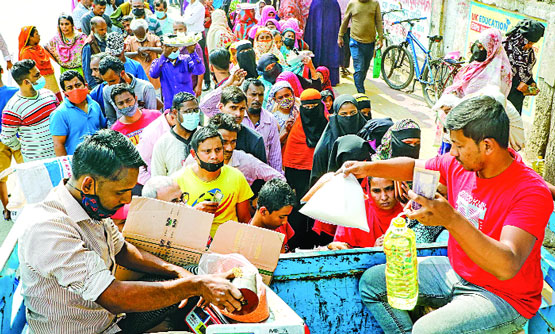Number of hungry people doubled in 6 months
Staff Correspondent: Amid high inflation, the number of people going hungry for an entire day has nearly doubled among lower-income groups in the past six months, according to a survey by the South Asian Network on Economic Modelling, or SANEM. Prof Selim Raihan, executive director of SANEM, presented the findings of the study on how lower-income groups are faring, their income and expenditure at Dhaka’s BRAC Centre yesterday.
The survey sampled 200 people from each of the country’s eight divisions between Mar 9 and Mar 18 for a total of 1,600 respondents. Half of those surveyed lived in divisional cities, while the rest were in upazila towns. However, all of them were from lower-income groups. The comparisons were made to information collected six months ago.
The survey asked respondents whether they had to go an entire day without food due to financial pressure or for any other reason. Six months ago, 9.75 percent had responded yes. In the latest survey, that number nearly doubled to 18.19 percent.
In the previous survey, 17.94 percent said they had to put off meals despite hunger. The number rose to 32.38 percent in the March study.
Over a third of respondents – 39.56 percent – said they had run out of food at home, up from 21.44 percent six months ago. Over seven out of 10 – 71.19 percent – said they were eating less than they needed, up from 42 percent six months ago.
The number of people skipping meals on occasion has gone up from 20.31 percent to 37.38 percent. Six months ago, 50 percent of respondents said their daily food was limited to a few selected items. That number rose to 78 percent in March.
The number of people at risk of severe hunger more than doubled from 12.25 percent six months ago to 25.44 percent. Compared to rural areas, the poor in urban areas are facing more difficulties with food, with 20 percent facing a severe food crisis in rural areas, while the number is 30 percent in urban areas. People in rural areas have also spent more on non-food items in the past six months than people in towns.
Six months ago, about 29 percent of respondents said they were fairly secure in their food intake. That has dropped to 8 percent.
Of the respondents, 28 percent – 456 people – were registered on the OMS and TCB lists as beneficiaries. Some of the others qualify for other social assistance.
Dr Sayema Haque Bidisha, one of the members of the survey team, said the survey shows the significant impact of the current inflation on the lives of the common people of Bangladesh.
Most of the respondents in the survey work in the informal sector, she said. Their monthly income does not exceed Tk 14,000. In the past six months, we have seen their expenses balloon, while their income remains the same. To survive, these people are taking small loans, including from micro-credit firms. This means they are likely to enter a vicious cycle of debt, she said.
Data from the Bangladesh Bureau of Statistics shows that overall inflation rose 8.78 percent in February, compared with 6.78 percent a year earlier.
Rare Israeli airstrike in Beirut kills Hezbollah commander and more than a dozen others
International Desk: Israel launched a rare airstrike that killed a senior Hezbollah milita…








